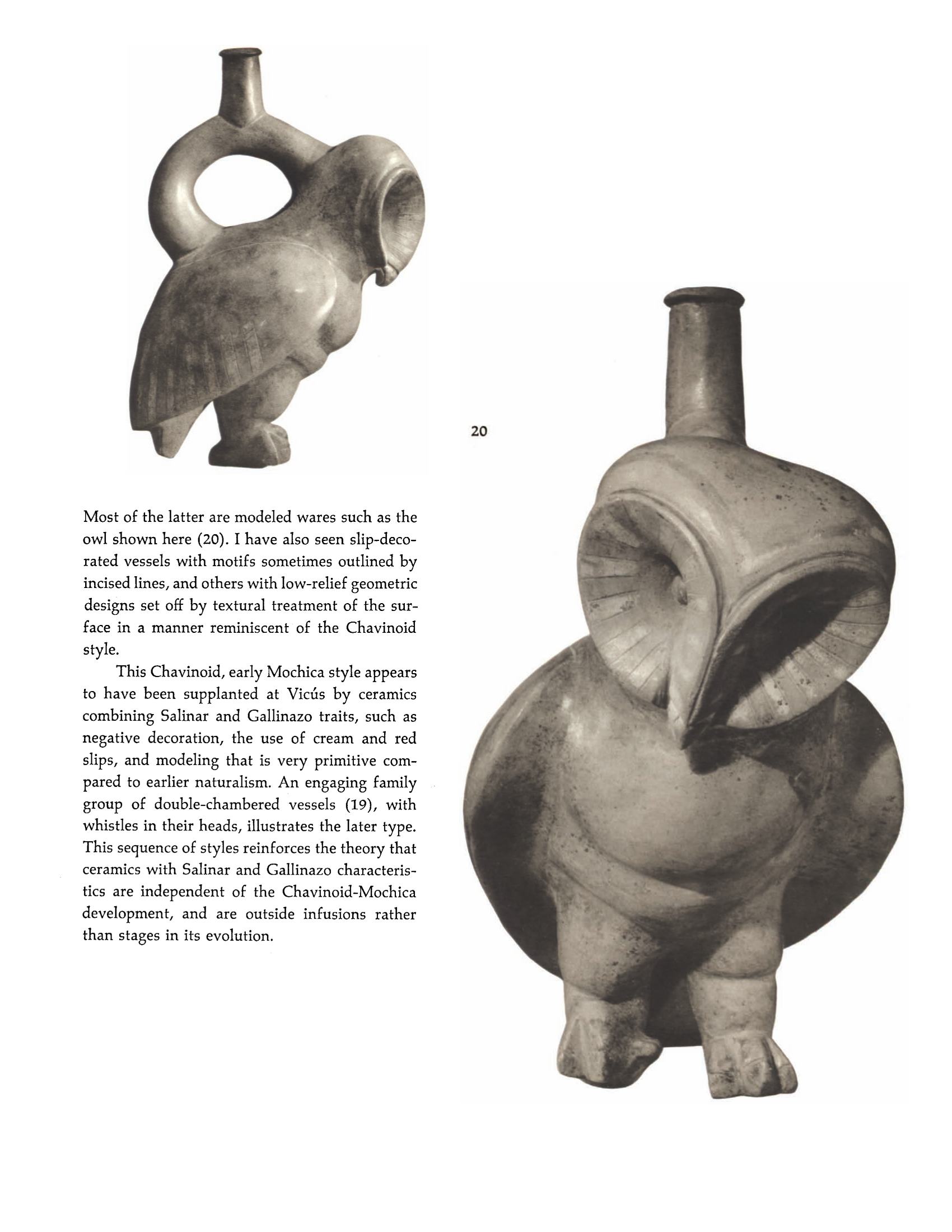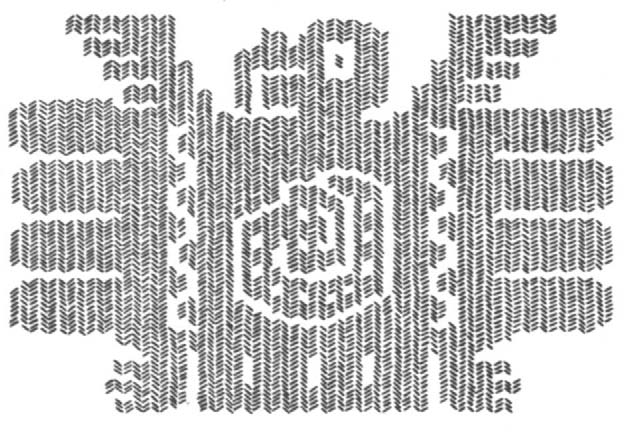|
|
Alan R. Sawyer. Ancient Peruvian Ceramics: The Nathan Cummings Collection. — New York, 1966  Ancient Peruvian Ceramics: The Nathan Cummings Collection / by Alan R. Sawyer with drawings by Milton F. Sonday, Jr. and photographs by William F. Pons and William E. Lyall. — New York : The Metropolitan Museum of Art, 1966. — 144 p., ill.PREFACE
The trained eye and connoisseurship of Alan R. Sawyer, his practical field experience in Peruvian archaeology are well known. His intimate association in helping Mr. Cummings in the building of his collection of Peruvian pottery since its inception, and his appreciation of its great historical and artistic interest suggested that Mr. Sawyer rather than anyone else should prepare this fascinating factual treatise. We are grateful to Mr. Sawyer and to the Trustees of The Textile Museum in Washington, of which he is the Director, for granting the time required to prepare this book.
The generosity of Mr. and Mrs. Nathan Cummings in presenting the major part of the collection described in the following pages and their making possible this publication is indeed appreciated by the Trustees and the staff of The Metropolitan Museum of Art.
James J. Rorimer
Director
INTRODUCTION
Peru occupies the central portion of the mighty Andean mountain chain that closely parallels the western edge of South America. Here the blue Pacific pounds a narrow ribbon of surf against a 1,300-mile-long coast of jagged rocks and empty beaches. The narrow coastal plain is an ashen desert crowded by parched mountain spurs, which rise in awesome crescendo to lofty snow-capped peaks. The highest, Mt. Huascarán, over 22,200 feet in altitude and only sixty miles from the sea, forms part of the continental watershed. Cool winds from offshore are heated by the sun-scorched desert and, taking rather than giving moisture, rise upward as they move inland, until at last the altitude wrings them dry. Most of the precipitation flows rapidly into tributaries of the Amazon, which reach like tentacles into the heart of the mountains, drawing off moisture to be lavished on steaming jungle and swamp. Only a fraction of the water drains toward the Pacific, through about forty steep-walled valleys, many of which are dry much of the year. The fact that this arid mountain-crowded zone between jungle and sea gave rise to some of the most splendid of ancient American civilizations is a tribute to man's extraordinary ability to cooperate with his kind to overcome the most hostile of environments.
When the first human inhabitants roamed the central Andean area, about 11,000 years ago, the climate was not as harsh as it is today. Ample rain supported forests and grasslands in the highland and coastal valleys. Small nomadic bands of Stone Age men could easily subsist by hunting, fishing, and the gathering of wild fruits and vegetables. For several thousand years there was a gradual change in this way of life as the area became more and more arid, and the population was forced to concentrate in the few well-watered areas. We know almost nothing of the history of the highlands during this period, but on the coast vast shell heaps mark the location of early settlements, situated to reap the abundant harvest of the seashore. By 4000 b.c. some of these villages were practicing limited agriculture, raising such vegetables as beans, squash, and chili peppers to supplement wild food supplies.
Inhabitants of the first agricultural communities fashioned tools, weapons, and ornaments from stone, bone, shell, and wood. They had no ceramics, but made containers for food and liquids from bottle gourds, which they raised for that purpose. Baskets and mats were woven from rushes; other vegetable fibers, which by 3000 b.c. included domesticated cotton, provided material for nets and textiles.
The earliest known art objects from ancient Peru were found in one of these early, pre-ceramic village sites. In stratified refuse at Huaca Prieta, on the north coast near the mouth of the Chicama River, Junius B. Bird discovered fragments of decorated cotton textiles dating from 2500 to 2000 b.c. By carefully charting the warp movements in the twined fabrics, Dr. Bird has been able to reconstruct a large variety of highly stylized motifs, including condors (1), human figures, serpents, crabs, and pumas. He also found the fragile remains of two small gourds, their surfaces ornamented in low relief by cutting away the background and incising the inner details of the motifs. One is embellished with four boldly simplified frontal heads (2), possibly feline, while the other bears two similar faces attached to abstract and evidently anthropomorphic bodies, alternating with birdheaded serpents. The lid of the second exhibits an S-shaped device ending in bird heads, a motif also found on Huaca Prieta textiles. Dr. Bird's important discoveries, made possible by his skillful application of the most advanced scientific procedures, shine a thin ray of light into that remote and little-understood era in which Peru's civilizations began. The art of this humble village is surprisingly sophisticated and perhaps reflects developments at some more important but as yet unknown center. In both motifs and design conventions it forecasts much of the religious iconography of the great periods of ancient Peruvian culture that followed.
From 1500 to 1000 b.c., a number of important new technological advances appeared in Peru. They included domesticated maize, techniques of building with preformed adobes, the working of stone and metals, and the making of pottery. These innovations were manifestations of a startling acceleration of cultural progress throughout most of the central Andean region. In the matter of a few centuries, the northern people were united by a vigorous religious cult, called Chavín after its best-known highland ceremonial center, Chavín de Huántar. Here massive temples were built of finely dressed stone and embellished with spectacular friezes in low relief, carved columns, and other sculptural ornament. The subjects depicted were awesome feline-fanged deities (4), and dynamic birds of prey (3) and felines (5). Simplified versions of these powerful motifs and symbols derived from them were used by the Chavín craftsmen to ornament their well-made ceramics, beautiful objects of gold, silver, stone, shell, and bone, and textiles woven in a variety of techniques. Progress in the arts was matched by the growth of political and social institutions, and an increase in agricultural productivity achieved by improved irrigation and terracing.

3

4

5
The widespread influence of Chavín religion and the advanced technology associated with it acted as catalysts for the development of several distinctive regional cultures. Outstanding among these are the Mochica, which flourished on the north coast, and the Paracas on the south coast that, from similar Chavinoid beginnings, passed through a series of evolutionary stages to become the Nazca culture. In many ways, the craft achievements of these two peoples represent the apogee of ancient Peruvian art. For this reason, the period they represent has been called the Master-Craftsman, Florescent, or Classic period. Outstanding examples of ceramic art in the Nathan Cummings Collection offer us an unusual opportunity to document the history and character of both the Mochica and the Paracas civilizations. The collection also contains sufficient examples of subsequent styles for us to trace the major trends in pottery down to the time of the Spanish conquest.

The upper Ica Valley, as it wends its way into the mountains several miles to the northeast of Teojate
The purpose of this handbook is to aid the interested layman and student in the understanding and appreciation of an outstanding collection of ancient Peruvian ceramics. The treatment of the two major groups will, of necessity, be quite different. Mochica ceramics have already been studied and published in detail. Their stylistic development was simple and logical and their subject matter realistically presented, making interpretation relatively easy. The evolution of the Paracas culture was, on the other hand, extremely complex, and has not yet been adequately clarified by archaeological fieldwork. Its confusing array of styles is characterized by abstract religious symbols that lack the story-telling qualities of Mochica iconography. I shall attempt in both cases to present my own interpretation of available archaeological data, without such scholarly appurtenances as polemics and footnotes. A selected bibliography is included for the reader who would like to explore the fascinating realm of ancient Peruvian art in more detail.

Contents
Preface.. 5
Map of Peru.. 8
1. Introduction.. 9
Chronological Chart.. 13
THE NORTH COAST.. 15
2. The Formative Period.. 17
Cupisnique.. 17
Salinar.. 18
Gallinazo.. 20
Recuay.. 21
Vicús.. 22
3. Mochica Chronology.. 24
Mochica I.. 24
Mochica II.. 26
Mochica III.. 29
Mochica IV.. 31
Mochica V.. 32
4. Mochica Ceramic Art.. 35
Portraiture.. 35
Figure Vessels.. 39
Warriors.. 42
Runners.. 49
Modes of Representation.. 50
Religion.. 52
5. Other North Coast Styles.. 58
Highland Inca.. 63
Chancay-Inca..64
THE SOUTH COAST.. 67
6. The Great Discovery.. 69
7. The Early Ceramic Period.. 72
8. The Formative Paracas Period.. 73
9. The Ocucaje Early Paracas Style.. 79
10. The Ocucaje Middle Paracas Style.. 83
11. A Re-examination of "Necropolis".. 88
12. The Late Paracas Period at Ocucaje.. 91
13. The Proto-Nazca Period.. 96
14. The Juan Pablo Style.. 101
The Juan Pablo Feline Mask Motif.. 102
The Juan Pablo Feline Figure Motif.. 104
The Juan Pablo Fox Motif.. 107
The Juan Pablo Falcon Motif.. 110
The Juan Pablo Vencejo Motif.. 111
Additional Notes on the Juan Pablo Style.. 113
15. The Callango Style.. 115
The Callango Feline Motif.. 115
The Callango Falcon Motif.. 117
The Callango Fox Motif.. 118
The Callango Double-headed Serpent Motif.. 118
The Callango Human Face Motif.. 119
16. The Nazca Culture.. 122
17. The Early Nazca Style.. 123
18. The Middle Nazca Style.. 125
19. The Late Nazca Style.. 128
20. The Nazca-Wari Style.. 132
21. Late South Coast Periods.. 134
Color Keys.. 135
Notes on the Illustrations.. 136
Selected Bibliography.. 140
Index.. 142
Sample pages       
Download link (pdf, yandexdisk; 25,8 MB).
4 апреля 2020, 16:12
0 комментариев
|
Партнёры
|








Комментарии
Добавить комментарий